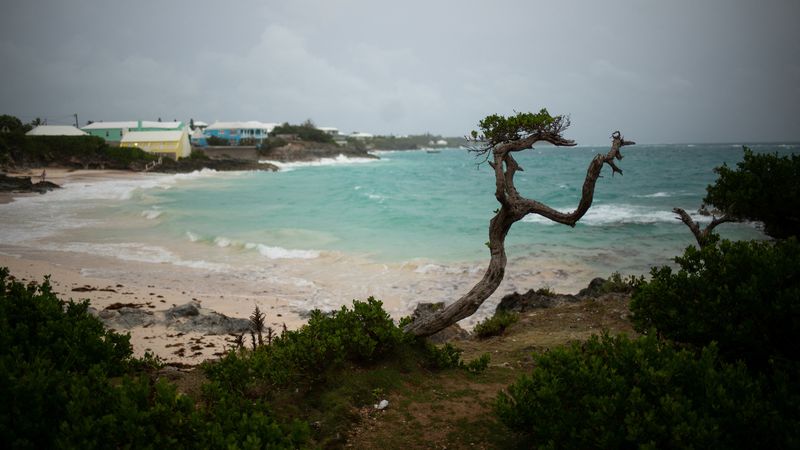By Don Burgess and Eric Martyn
HAMILTON, Bermuda/HALIFAX, Nova Scotia (Reuters) -Hurricane Fiona pounded the Atlantic island of Bermuda with heavy rain and winds on Friday as it tracked northward toward eastern Canada, where it threatens to become one of the most severe storms in Canadian history.
Fiona had already battered a series of Caribbean islands earlier in the week, killing at least eight and knocking out power for virtually all of Puerto Rico's 3.3 million people during a sweltering heat wave. Nearly a million customers remained without power five days later.
The storm approached Bermuda as a Category 4 hurricane but diminished a notch to Category 3 as it passed west of the British territory early on Friday. Still, gusts reached as high as 103 miles per hour (166 kph), the Bermuda Weather Service said in a bulletin.
The Bermuda Electric Light Co, the island's sole power provider, said about 29,000 customers, more than 80% of its customer base, had no electricity on Friday morning.
But Michelle Pitcher, the deputy director of the Bermuda Weather Service, said the territory appeared to be largely unscathed.
"It's been a long night but there are no reports of injuries or fatalities," Pitcher said. "There may be people with roof damage, but so far we haven't heard of anything bad. As I said, we build our houses strong."
Many Bermuda homes are built with small shuttered windows, slate roofs and limestone blocks to withstand frequent hurricanes.
By Friday afternoon, Hurricane Fiona was about 475 miles (770 km) south of Halifax, Nova Scotia, on Canada's eastern coast, moving north at 35 mph (56 kph) with maximum sustained winds of 130 mph (215 kph), the U.S. National Hurricane Center said.
'A BAD ONE'
The storm was upgraded back to a Category 4 hurricane on Friday, meaning it was capable of causing catastrophic damage.
Though it may weaken as it travels north over cooler water, Fiona is still forecast to be a powerful hurricane-force cyclone when it moves across Atlantic Canada, the National Hurricane Center said.
"We know that provinces have tremendous resources to support and prepare for this, but it's going to be a bad one," Canadian Prime Minister Justin Trudeau said during a joint news conference with South Korean President Yoon Suk-yeol in Ottawa.
"The federal government is mobilizing resources to support however needed, so please stay safe," Trudeau said.
The storm could prove more ferocious than the benchmarks of Hurricane Juan in 2003 and Hurricane Dorian in 2019, Canadian Hurricane Centre meteorologist Bob Robichaud told a briefing.
"Where it fits in the history books, we'll have to make that determination after the fact, but it is going to be certainly a historic, extreme event for eastern Canada," Robichaud said.
Fiona is expected to hit Canada's Cape Breton Island, home to about 135,000 people, or 15% of Nova Scotia's population, Environment Canada said on Friday.
A hurricane warning was in effect for most of central and eastern Nova Scotia, Prince Edward Island and Newfoundland, provinces on the east coast of Canada. The center of the storm was forecast to approach Nova Scotia later on Friday, move across the province and into the Gulf of St. Lawrence on Saturday, and cross over Labrador on Sunday, the hurricane center said.
Forecasters say areas close to its path could get up to 8 inches (20 cm) of rain, while winds could damage buildings and cause utility outages, with storm surges swamping the coastlines. The country's two largest carriers, Air Canada and WestJet Airlines, are suspending regional service starting Friday evening.
PUERTO RICO SLAMMED AGAIN
Fiona already displayed its devastating strength in the Caribbean, killing at least four people in Puerto Rico, the U.S. Federal Emergency Management Agency said.
The storm reminded many Puerto Ricans of the devastation caused by Hurricane Maria five years ago, from which the island has yet to fully recover.
Javier Rivera-Aquino, 50, who was a farmer in Lares, Puerto Rico before Maria destroyed his livelihood, said area farms were still digging out, with coffee fruit knocked off the plants grown in the mountains and whole banana farms washed out in the valleys.
"Total devastation," he said. "They're hit bad and I'm not sure what they'll do."
